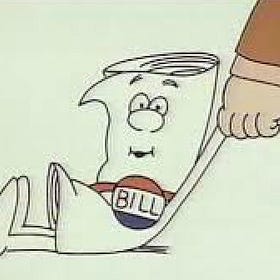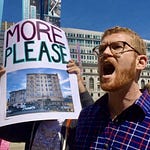We were extremely pleased to chat with Jess Remington, a Research Analyst at Economic Innovation Group. Jess previously worked at the U.S. Department of Housing and Urban Development as an economist on Fair Market Rents and Income Limits. She has also held prior roles at the Mercatus Center, the Brookings Institution, and The Atlantic, and is the founder of DC YIMBYs.
Her recent article, titled Not Just Suburban Sprawl — Dense Places Can Still Build, made a compelling case that the problem is legal, not physical — that the issue isn’t land; rather, many jurisdictions have effectively outlawed the kinds of housing that meets modern demand, with zoning codes often prohibiting even small apartment buildings and existing homeowners frequently blocking reform.
We look forward to Jess’s future contributions to housing policy research!
Crisis Unveiled: Defining Housing Woes (00:00:00 - 00:03:17)
Housing affordability struggles stem from a clear shortage, where buying a home now demands over five years of median income, double the 1970 figure of two and a half years.
High interest rates compound elevated prices, requiring nearly twice the 1980s income for down payments and pushing monthly payments to 30-year highs.
Generational divides show seniors boosting overall homeownership rates since the 1980s, while younger groups lag: Gen X down 6 points, millennials 10 points from 1982 levels.
This disparity hits newcomers hardest, sparing incumbents, and persists regardless of marital status, debunking lifestyle shift claims.
Burden Breakdown: Beyond Income Shares (00:03:48 - 00:05:56)
Rising rent burdens understate issues, as people trade off quality—opting for smaller spaces, roommates, or distant, riskier neighborhoods—to cap spending at 25% of income.
Downstream effects include fertility drops; a $10,000 home price rise cuts rates by 2.5% among non-owners, outpacing unemployment’s impact.
Fertility links tie into family formation delays amid unaffordability, amplifying broader societal shifts.
Typology Tangles: Family Housing Gaps (00:05:58 - 00:08:03)
Market-driven multifamily builds favor studios over family units, but claims of typology mismatches don’t fully hold, as one- to four-bedroom prices correlate tightly across metros.
Incentives for three-bedroom apartments often fill with roommates, not families, questioning policy efficacy in altering demand responses.
While more family-friendly options are needed, developer subsidies may not shift outcomes significantly without broader demand changes.
Regulatory Roots: Zoning’s Grip (00:08:08 - 00:09:32)
Zoning emerges as the core friction, blocking supply despite demand, deviating from market equilibria where high-income areas could afford more but face barriers.
Beyond zoning, building codes, permits, and environmental rules fragment markets, preventing scale and innovation.
Even absent regulations, subsidies aid low-income groups, but middle-income unaffordability largely traces to these constraints.
Hybrid Hopes: Rent Control and Incentives (00:09:47 - 00:13:05)
Jersey City’s model pairs rent control on pre-1980 buildings with developer incentives for transit-oriented high-rises, avoiding new construction caps and yielding price disparities.
Streamlined permitting and minimal parking requirements enable massive builds, contrasting inefficient timelines elsewhere, where multifamily projects doubled since 2000.
This efficiency boosts units without endless hearings, outperforming places like New York or Florida in balancing resident security and long-term equilibrium.
Productivity Puzzle: Construction Challenges (00:13:09 - 00:18:23)
Construction costs now claim 65% of new home prices, with labor up 5% last year; taller buildings escalate expenses, clashing with dense-area needs for “missing massive” housing.
Firms remain tiny—median five to six employees—due to patchwork rules varying by town, stifling economies of scale unlike manufacturing’s growth.
Off-site factory builds advance but falter against local codes; union wages widen gaps, yet regulatory fragmentation blocks broader efficiency gains.
Immigration’s role in subsidizing labor may dampen innovation incentives, though evidence remains conjectural.
Federal Fit: Government’s Role Explored (00:18:26 - 00:20:51)
Federal incentives could tie transportation funds to zoning reforms, pressuring states to ease barriers and foster regional coordination.
Bipartisan bills like YIMBY Act propose grants for upzoning near transit, while HUD could enforce fair housing via zoning scrutiny.
Challenges arise from local control preferences, but conditional funding mirrors successful infrastructure models, potentially unlocking supply.
Demand Drivers: Immigration and Demographics (00:20:52 - 00:23:32)
Immigration surges demand, with post-pandemic inflows straining undersupplied areas; policies could condition federal aid on accommodating growth.
Household shifts—more singles, smaller families—necessitate diverse units, as nuclear families decline since 1960.
Elderly multigenerational living rises, underscoring needs for adaptable housing amid aging populations.
Mortgage Maze: Financing Frictions (00:23:35 - 00:26:48)
Mortgage interest deductions favor owners, distorting markets; reforms could cap benefits or phase out for high earners to level renter-owner dynamics.
Rate lock-ins from low pre-2022 mortgages hinder mobility, exacerbating shortages; federal tweaks might encourage refinancing incentives.
Proposals include taxing imputed rent or expanding deductions to renters, though political hurdles loom large.
Beyond Borders: Global Lessons (00:26:50 - 00:29:32)
Tokyo’s success stems from national zoning overrides, enabling rapid builds and stable prices despite density.
Vienna’s social housing model, funding 80% of builds via developer taxes, yields affordability but faces scalability issues in the U.S.
Singapore’s public provision covers 80% of residents, blending ownership and rentals effectively.
Equity Echoes: Distributional Impacts (00:29:35 - 00:32:48)
Low-income groups suffer most from shortages, with voucher waitlists spanning years; expanding programs could aid, though supply remains key.
Middle-class squeezes arise from regulatory costs inflating prices, while seniors benefit from locked-in low taxes.
Racial disparities persist, with Black homeownership gaps widening; reforms must address historical barriers.
Incentive Ideas: Policy Innovations (00:32:50 - 00:35:32)
Tax credits for first-time buyers or low-income developers could spur supply, modeled on successful energy incentives.
State preemptions on lot sizes and parking mandates show promise, as in Texas and Montana.
Bipartisan momentum builds for reforms like Rhode Island’s housing bill.
Density Debates: Crime and Community (00:35:35 - 00:38:22)
Polls highlight crime fears as top building concerns, but research ties it more to socioeconomics than density.
New York City’s low rates in dense Manhattan contrast higher suburban or rural crimes in Memphis or St. Louis.
Affluent areas show no crime spikes from densification, emphasizing economic factors over built form.
Build Patterns: Density’s Surprising Surge (00:38:26 - 00:42:03)
New builds peak in low-density exurbs but dip in inner suburbs with strong NIMBYism, then rise in densest urban cores.
San Francisco outbuilds Napa Valley per capita, driven by downtown allowances for large apartments.
Case studies like D.C., Seattle, Atlanta, and Jersey City match suburban Phoenix’s per-capita growth through transit focus and efficiency.
Bay Barriers: Fragmented Governance (00:42:19 - 00:43:30)
San Francisco Bay’s siloed cities create distortions: ample building in San Jose and SF, none in Palo Alto, failing to internalize regional costs.
Induced demand from rising prices spurs builds, but rent turnovers dry up starts, per Feldman and Murray.
Future Fears: Overbuilding Risks (00:43:32 - 00:48:00)
Long-term zoning benefits accrue over 40+ years, favoring future residents and explaining NIMBY instincts.
Waning demand from low immigration echoes Japan’s deflation, risking debt-fueled crises, but current underbuilding buffers against overbuilds.
Austin and Tampa’s booms stabilized prices amid migrations, without local recessions.
Shifting households demand smaller units, as nuclear families wane and multigenerational rises.
Optimism Outlook: Solvable Paths Ahead (00:48:33 - 00:51:56)
Housing reforms evoke marijuana decriminalization’s bipartisan momentum, with state preemptions on lots and parking advancing.
YIMBY Act gains traction; even modest builds in D.C. and Seattle yield affordability gains versus peers.
Equilibrium remains distant, with ample room for growth before overbuild risks.
Tax Troubles: Property and Land Values (00:52:03 - 00:56:01)
Prop 13 locks in low taxes, widening bid-ask spreads and rate lock-ins; state reforms needed, though unpopular.
Land value taxes succeed initially in declining areas like Pittsburgh but face backlash amid growth.
Federal role unclear, but smoothing differentials could boost turnover and discovery.
Momentum Moments: Political Shifts (00:56:03 - 00:57:05)
Newsom’s abundance shoutout signals national traction, mirroring grassroots bipartisan pushes.
Consensus grows on targeted reforms, fostering optimism amid complexity.
Thank you!
…to Jess and everyone who tuned in live.
Join us for our next Substack Live on Wednesday 10/29 at 5:30pm ET with Cameron Murray, the economist and consultant who specialises in property markets, environmental economics, and corruption. He has done some incredible work in demystifying the housing debate — beware: some of his views may be contra-YIMBY! — and Dr. Murray is also the author of a 2024 book titled The Great Housing Hijack.
Download the Substack app to tune in to future Boyd livestreams:
As a reminder…
If you or someone you know is interested in competing in the Boyd Essay Contest for a chance at $2,500 cash and a Boyd fellowship, the submission window is open through the end of October. Less than a week left! Details here:
Boyd Essay Contest: Call for Submissions
We’re looking for essays that answer one simple question: What’s an actionable, outside-the-box solution to America’s housing crisis?
And some more context here:
The Next Big Pro-Housing Bill Could Have Substack Origins
This is a chance to speak truth into the world. Take it!




















